Fitness program for gaining muscle mass. Gain weight quickly
When it comes to choosing a workout program, it can be difficult to find the right one for you. And all because the body of each of us reacts differently to physical exercise, more precisely on the number of repetitions and working weights. Let's start by deciding on the goal. For a male bodybuilder, as for a woman, the primary thing is not muscle definition, but mass gain. That's where we'll start.
Increase in muscle volume
There are no specific mass gain formulas that will work for all men. Even after choosing a standard training program, the athlete must monitor his body. The first is the correct working weight. Select equipment so that you can complete the recommended number of sets and repetitions. The next step for a man is to observe how the body responds to the received load. Here are two main factors that contribute to recruitment progress muscle mass.
Program selection
The best option for male athletes if their goal is to gain muscle mass is split training. That is, at each training session one group is worked out. This way the muscles have enough time to rest, which guarantees progress in mass gain.
The program can be written as follows (as an example):
- Breasts;
- Biceps and triceps;
- Shoulders;
- Back;
- Legs.
This mass complex includes universal exercises for men, regardless of their physique. The training program can be modified or supplemented with other techniques suitable for each athlete individually. The same goes for the number of approaches and repetitions.
How to get the maximum?
To achieve maximum effect, pay attention to the following points:
Muscle failure. In each exercise of the program for men, you should work until failure occurs, otherwise the mass-gain process will be less effective.
Negative phase. During training, you should focus on the negative phase of the movement. That is, more time is spent lowering the projectile than raising it. For example, the weight moves up for 1-2 seconds, down for 3-6. This training approach guarantees muscle mass gain.
Training program for men
At the beginning of mass training, we warm up well. Spend 5-7 minutes doing cardio. At the end of the workout, do not forget to cool down for 5 minutes and stretch your muscles well.
The program is designed for athletes with an average level of training.
Visually, the program looks like this::
Ready. Let's get started:
Training pectoral muscles(Monday)
At the end of the workout:
Crunches– 4*15-20 times
Leg program (Tuesday)
Squats(classic version)
Lunges with a barbell
Sumo squats
Leg Curls
Calf training in the simulator
Crunches– 4*15-20 times
Wednesday (rest, ab work)
Crunches with legs raised– 4*15-20 times
Leg raises on a bench – 4*15-20 times
Back and biceps (Thursday)
Wide grip pull-ups
Barbell row to chest
We will start this article on muscle growth with the golden rule of bodybuilding, which is as follows: “to gain mass, you should use mainly basic exercises,” since they are excellent for this purpose. However, mindlessly doing these exercises is unlikely to lead to large muscle gains.
As Joe Weider, a famous trainer and founder of the International Federation of Bodybuilding (IFBB), noted, muscles respond to loads differently, depending on the weight of the weights and the number of repetitions in the approach. Thus, if your goal is to gain muscle mass, then you should proceed, first of all, from these rules.
This PT can be used by athletes of any level!
- Perform exercises with a weight that you can lift 6-12 times. It is this approach to training that will lead to an increase in muscle strength and will place maximum emphasis on increasing your mass. If you perform fewer repetitions, then the emphasis will be more on increasing strength rather than muscle volume, but if the number of repetitions is more than 12, then the emphasis will shift from increasing muscle mass to developing muscle endurance. Therefore, during mass training, it is important to stay in the range of 6-12 repetitions, no more and no less.
- You should train according to this program three times a week. The rest time between approaches is 1-3 minutes (see how you feel - if breathing is restored, proceed to the next approach). Rest between exercises - 2-3 minutes (not approaches, but exercises).
- The training time should be no more than 60 minutes (this does not include warm-up and cool-down). Why? Because the peaks of testosterone and growth hormone activity occur at 35-45 minutes of training. But cortisol (a catabolic hormone) begins to rise after the 30th minute of training. After just 40 minutes, concentration and intensity begin to decline (our mental center - the brain - begins to weaken). Therefore, build your workouts in this time period for maximum efficiency.
- Each workout should begin with a warm-up (read more about warm-up) and end with a cool-down - light cardio for 3-5 minutes and muscle stretching for 5-7 minutes.
- The training should begin with basic exercises! The first approach in each exercise is always a warm-up, with a light weight. Try to do the last approach to failure, but failure in the previous ones is not advisable.
- Important advice - PT for gaining weight should be changed periodically so that the muscles do not adapt to it. Don't forget that for PT to be more effective, you must increase the weights - i.e. PROGRESSION OF LOADS MUST BE PRESENT!
- Follow the technique. Even if at first the flaws in your technique go unnoticed, when your strength indicators increase, the risk of injury will be quite large, and the recovery period from injuries can drag on for months!
- Perhaps the most important advice: you simply MUST eat right (it is also advisable to take sports nutrition, it will help you gain muscle mass). Without a proper and competent diet, all your workouts will be WASTED.
- Try not to do a lot of cardio per week, 1 time will be enough between training days. Perform all exercises at an average pace. Give yourself at least 8 hours of sleep and rest per day.
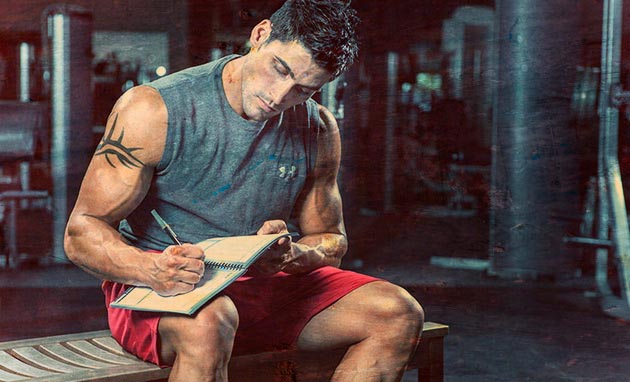
Training program for building mass
Monday (Chest, Triceps)
- Bench press - 4 sets of 12, 10, 8, 6 reps.
- Barbell press incline bench- 3 sets of 10 repetitions.
- Lying dumbbell flyes/incline dumbbell flyes - 3 sets of 8-10 reps.
- Bench press with a narrow grip - 4 sets of 12, 10, 8, 6 repetitions.
- Bench push-ups - 3 sets of 10 reps.
Wednesday (Back muscles, Biceps)
- Deadlift - 4 sets of 12, 10, 8, 6 reps.
- Pull-ups wide grip- 3 sets of 8-10 repetitions.
- Bent-over barbell row/reverse grip bent-over barbell row – 3 sets of 8-10 reps.
- Barbell curls for biceps - 4 sets of 12, 10, 8, 6 reps.
- EZ barbell curls on a Scott bench - 3 sets of 10 reps.
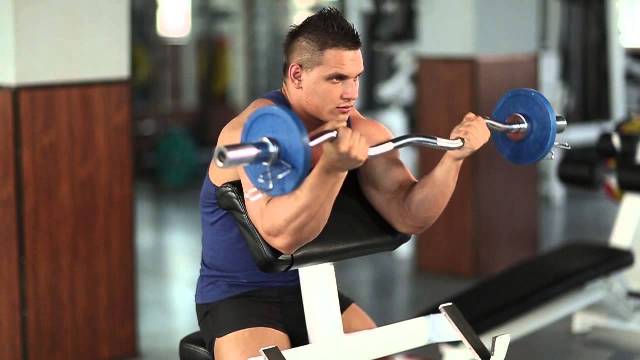
Friday (Legs, Deltas)
- Squats with a barbell on the shoulders - 4 sets of 12, 10, 8, 6 reps.
- Lunges with a barbell on the shoulders - 3 sets of 8-10 reps.
- Calf raises - 3 sets of 8-10 reps.
- Barbell press standing (or sitting) - 4 sets of 12, 10, 8, 6 repetitions.
- Standing dumbbell flyes - 3 sets of 8-10 reps.
At the end of each workout, you can add abdominal exercises, such as hanging leg raises and crunches in 2 sets of 15-20 repetitions.
Friends, support our group on Facebook, share this post with your friends or click the “Like” button! and you will always be in the know latest news"Duty Rocking Chair"!
Gain weight quickly it is possible without pharmacology, but for this you will need a competent plan for gaining muscle mass, a corresponding diet, some level of training and a real desire to achieve your goal, since the program will force you to build your entire life schedule around training and recovery. A complete beginner will not be able to gain weight quickly, the athlete should already be more or less prepared, that is, the athlete must learn the technique of performing the exercises, already have good neuromuscular connections, in general, the athlete’s training experience should be about six months. If you just came to the gym and are looking for a program with which you will amaze everyone on the beach next summer, then you need to study the rules of bodybuilding for beginners and use the appropriate training program.
A well-trained athlete will also not be able to gain weight quickly, well, that is, if you weigh 100-110 kg, then this plan for gaining muscle mass, of course, will work for you, but not as noticeably as for an athlete weighing 70-80 kg. This does not mean that the program for a trained athlete will not be effective, on the contrary, it’s just that you can quickly gain weight only up to a certain stage. Let's say, if an athlete with a mass of 70-80 kg can gain 10-12 kg in 4-5 months on this program, then an already trained athlete will gain only 4-6 kg, but his mass will be of better quality. You need to understand that, in general, it is impossible to gain more than 5-7 kg of muscle cells in a year without pharmacology. Those 10-12 kg that an athlete weighing 70-80 kg will gain will consist of 50-60% water, creatine and other “muscle factors”, but 4-6 kg of a trained athlete will for the most part formed by hypertrophy of the myofibrillar apparatus.
Significant advantages of this muscle mass gain plan are: the program’s ability to even out imbalances in the development of individual muscle groups, a significant increase in the athlete’s strength, development of the functional qualities of the body and improvement of muscle fullness. Since it is possible to quickly gain muscle mass solely due to the hypertrophy of large muscle groups, the program involves more intensive training of the legs and chest, and the athlete trains his back, although less intensively, but more extensively, while the remaining muscles are trained either indirectly or exclusively “auxiliary” exercises. However, the training plan consists of 4 phases, so each phase has its own rules and priorities, but, in general, the program is aimed at developing hypertrophy of large muscle groups.
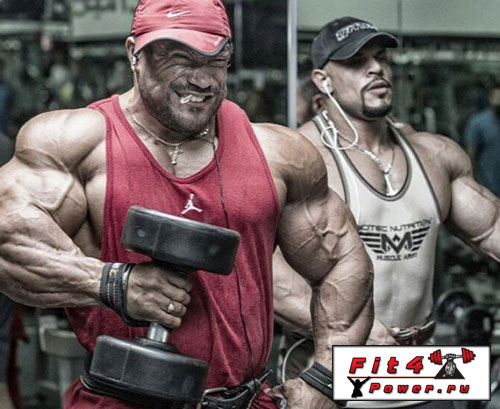
That is why this scheme is recommended to be used at the initial stage of training, since the first thing a bodybuilder must do is increase the total volume of muscle mass, which will also ensure a quick gain in mass of small muscle groups. The point is that the body, in any case, distributes resources more or less evenly in order to maintain homeostasis, as a result of which, by pumping up your legs, you will also increase the mass of your arms. This does not mean that the arms will grow at the same rate as the legs, but since the legs are much larger than the arms, at the initial stage priority should be given to them, since if you give priority to arm training, then the total amount of growth factors produced will be less , but they will still be distributed between all muscles. In other words, in an absolute sense, training small muscle groups, at the initial stage, less stimulates the growth of both large muscles and the small muscle groups themselves. In the future, if you want to focus on your hands, you can use the Plintovich program.
First stage fast weight gain
This phase is called "three sixes" , since it involves performing 6 exercises in 6 sets of 6 repetitions per workout. In each exercise, the athlete must reach failure, but only in the last repetition, that is, the athlete trains according to the pyramid principle, increasing weight gradually. This phase lasts 4 weeks, during which the athlete must complete 12 workouts, training every other day. Rest between approaches is 60-90 seconds, despite the fact that the athlete uses the pyramid principle, it is necessary to warm up. Since it is almost impossible to withstand such a volume of training with a weight of more than 80 kg without the use of pharmacology, athletes with such a weight need to break the training into 2 parts (workout A and workout B), alternating them every training day. Accordingly, if you perform 3 exercises per workout, then you need to complete 16 workouts per cycle, so it will last 4.5 weeks.
A)
Standing Barbell Chest Press – 6 sets of 6 reps
A)
Bench press - 6 sets of 6 reps
A)
Classic deadlift - 6 sets of 6 reps
B)
Bent-over barbell rows - 6 sets of 6 reps
B)
Standing biceps with barbell - 6 sets of 6 reps
B)
- 6 sets of 6 reps
IMPORTANT * At the end of the first phase, the athlete must take a complete rest from training for 7-14 days! It is recommended to take creatine, taking a break between phases; The amount of food is not limited, you need to eat as much as possible.
Second phase muscle gain plan
The second phase is called "variable rate" , since the athlete switches from circuit training to split training, and the regime of repetitions and approaches also changes. An athlete should train 3 times a week, every other day, with 2 days rest between weeks. Rest time between sets is 60-90 seconds. The duration of the second phase is also 4 weeks, during which the athlete must complete 12 workouts. The athlete does fewer approaches per workout, so the CP decreases, but the number of repetitions in the approaches is from 10 to 2. This means that the athlete is already working not only on developing strength indicators, but is also training nervous system.
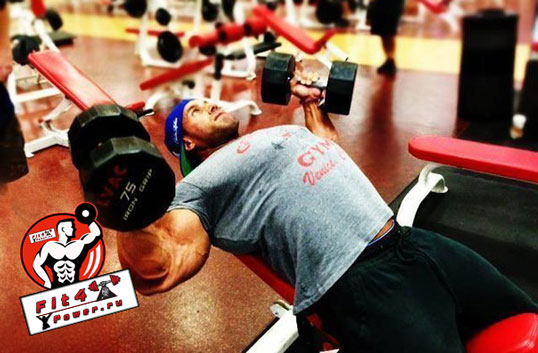
It goes without saying that in each exercise the failure repetition is only the last, and in those exercises where the range of repetitions is indicated, it is meant that in the first approach the athlete must do the maximum number of repetitions, and in the last the minimum. In all other approaches, the athlete gradually reduces the number of repetitions and increases the weight, independently deciding how many repetitions to do, but in the first approach he must do the maximum number of repetitions, and in the last he must reach failure in the minimum number of repetitions. This is necessary because it is in this mode that you will gain weight the fastest!
Workout #1
Squats with a barbell on the shoulders - 6 sets of 10-2 reps
Dips – 4 sets of 8 reps
Power press – 6 sets of 8-2 reps
Bent-overs with a barbell – 3 sets of 8 reps
Bent-over barbell rows – 4 sets of 8 reps
Standing biceps curls – 4 sets of 10-6 reps
Workout #2
Bench press – 6 sets of 10-4 reps
Barbell cleans – 3 sets of 6-3 reps
Deadlift – 6 sets of 8-3 reps
Bench press sitting behind the head - 3 sets of 8 reps
Leg press – 4 sets of 8 reps
Workout #3
Hyperextension – 3 sets of 10 reps
Deadlift – 5 sets of 8-3 reps
Incline Press – 5 sets of 8 reps
Lat Pulldowns – 4 sets of 8 reps
Classic barbell squats – 5 sets of 10-4 reps
IMPORTANT * At the end of the second phase, the athlete must take a complete rest from training for 7-14 days! It is recommended to take creatine supplements with a break between phases; The amount of food is not limited, you need to eat as much as possible.
Third stage gaining weight quickly
The third phase is called "impact split" , since this stage allows you to load almost all muscular and non-muscular systems of the body. You will be able to restore the capillary network, work on strength indicators, load the nervous system and pump up the myofibrillar apparatus. In other words, all the previous phases were just a lead-up to the third, which will ensure rapid weight gain. The rules here are the same as in the previous phase, with the exception of the training schedule and the number of approaches. Athletes weighing up to 80kg can train 4 times a week 2 through 1, that is, 2 training sessions in a row, a rest day and 2 training sessions in a row. Athletes with larger masses can train simply every other day, with rest every 4 training sessions in 2 days. In total, you need to complete 20 workouts per cycle. The range of approaches allows you to choose the number of approaches depending on how you feel.
Workout #1
Power bench press – 8-10 sets of 15-1 reps
Barbell squats – 8-10 sets of 15-2 reps
Dips – 5 sets of 5 reps
Workout #2
Barbell cleans – 2 sets of 5 reps
*
– 6-8 sets of 6-8 reps
Standing Barbell Chest Press – 4 sets of 4 reps
Standing bicep curls – 5 sets of 8 reps
IMPORTANT * At the end of the third phase, the athlete must take a complete rest from training for 7-14 days! It is recommended to take creatine supplements with a break between phases; The amount of food is not limited, you need to eat as much as possible.
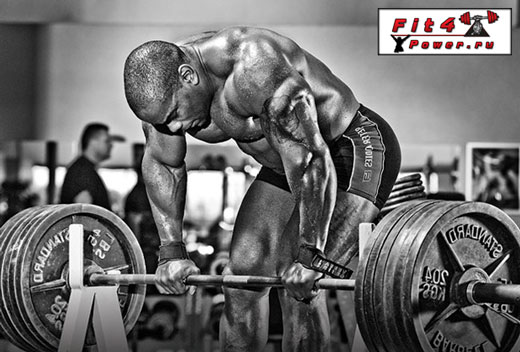
This is a classic deadlift, in which the barbell is placed on a hill, about 7-10 cm higher than usual, that is, the athlete simply works in a shorter amplitude.
Fourth stage fast weight gain plan
The final stage of the program for rapid weight gain is called "three tens" , since the athlete will have to complete 9 circuit training sessions over three weeks, consisting of 3 exercises performed in 10 sets of 10 repetitions. After this phase the program ends, but we emphasize , At the end of it, you need to rest for 14-21 days, after which you need to engage in some kind of recovery program for 2 months, such as a three-day split or pumping program. Then you should rest for another 1-2 weeks and you can switch to the Plintovich system.
During my transformation from the fat guy you see in the picture to the dude next to me, I went through many stages of “cutting” and gaining muscle mass. If someone tells you that you can grow muscles and burn fat at the same time, he is either mistaken or deliberately misleading you. This is only possible in theory. But in practice, you either grow both muscle and a little fat, or actively burn fat and at the same time lose some muscle volume. This is a harsh truth, but it was this technique that helped me transform. During my practice, I dried out 3 times and gained weight 2 times before I became like in the photo.
Therefore, a training program for gaining weight does not involve simultaneous fat burning. First, we gain muscle mass, then we dry out.
The complex is usually divided into a split of three days. For example, Mon, Wed, Fri. On some days we train certain muscles, on other days we train others. While some muscles are training, others are resting. The number of repetitions is moderate. On average, this is 10 repetitions. There are a huge variety of different TRAINING PROGRAMS and, as a rule, they alternate so that the muscles do not adapt to the load.
Training program for gaining weight.
Day 1. Legs.
Friends, sorry, there are no separate pages with exercise techniques yet, but soon there will be and I will provide links.
Barbell squats 3 x 10 (3 sets of 10 reps)
Lunges with dumbbells 3 to 10
Deadlift 3 x 10
Calves in any machine 3-4 sets of 20-25 repetitions
Day 2. Chest, shoulders.
Bench press 3 x 10
Lying dumbbell raises 3 to 10
Chest style dips 3 x 10
Standing dumbbell swings 3 to 10-12
Seated dumbbell press 3 to 10-12
Day 3. Back, biceps, triceps.
Pull-ups 3 max
If you do less than 5 pull-ups, perform vertical block rows 3 x 10
Bent-over barbell rows 3 x 10
Reverse grip vertical block rows 3 x 10
Close grip bench press 3 x 10
Biceps with barbell standing 4 to 12-15
All exercises are performed to failure. Rest between sets is on average 2 minutes, between exercises - 3 minutes.
Diet example:
Breakfast: 70-100 g of dry oatmeal + 2-5 whole eggs (with yolk)
Second breakfast: 2-3 bananas + nuts (30-50 g)
Lunch: 50-100 g buckwheat or rice (all cereals are weighed dry) + fish or meat, 150 g.
Afternoon snack: cottage cheese 150 g or kefir 0.5 l. (low fat) + bananas
Dinner: buckwheat (50-100 g) + meat or fish (low-fat, of course) 150 g.
At night, you can have cottage cheese or kefir, 150 grams
If you don’t gain weight with this diet, then your caloric intake will need to be increased.
This is one of the options for the training complex. Each cycle usually contains several such programs. Plus, very often, with slow recovery abilities, you have to train a group not once every 7 days, but once every 10 or even 12 days! But at the first stage, as a rule, progress occurs even with training once every 7 days. In my COURSE FOR MEN this information on training and nutrition is written out on about 50 pages (8 training programs, separate nutrition plans, alternation, etc., etc. For more details, see the link above). The course describes all the current and WORKING schemes for cutting and gaining muscle mass. This is a kind of transformation plan, following which I came to my result, and I am sure that you will come.
Thank you for reading to the end)
The month of March has crept up unnoticed. It would seem that only recently we were devouring Olivier for New Year's table, and now it’s already on the threshold - spring. Due to this significant event We are launching a series of program notes for the next month (or maybe two). And the first sign of it will be an analysis of the training program for gaining muscle mass.
So, take your seats in the auditorium, let's start broadcasting.
Training program for gaining muscle mass: questions and answers
Tell me, honestly: what girl doesn’t want to lose weight and what guy doesn’t want to gain muscle mass? That's right, there are none :). This is probably why the query “training program for gaining muscle mass” is one of the most popular searches for information. On the project, we try to approach any issue in a comprehensive manner, and often even the most mossy topic is “distributed” into several articles: in 2, or even in 3 parts. Of course, we will reveal the mass-gaining PT in several parts (if you don’t understand, this is how I’m preparing you for the upcoming tediousness :)). What will come of this, we will find out over time.
In general, it is worth saying that March-April are very successful months in terms of revealing program topics, because having a ready-made and understandable training program in hand, you can 2-3 months (i.e. until beach season) improve (and in some cases significantly) your figure. All you need to do is select the PT that suits your goals, print it out and blow into the room for its practical implementation. Of course, the most correct option is to create a program for each specific person, taking into account his health characteristics and schedule/regime. But it often happens that either finance sings romances, or there are no competent and adequate mentors in the room who care about the result of a person they don’t know. Conclusion - it is always better to study than to wait for the perfect opportunity.
Actually, this was an introductory one, let's get closer to the point.
Note:
For better assimilation of the material, all further narration will be divided into subchapters.
How do muscles grow? Mechanisms of growth
In our previous notes we already talked about. Therefore, we will not repeat ourselves verbatim, but will only recall the main points that will allow us to dive a little deeper into the topic of mass gain.
Muscle growth (hypertrophy) is the development of muscle cell mass, density, shape and function. Muscle proteins (actin/myosin) make up about 20% muscles, the rest 80% account for phosphates, water and minerals. Muscle growth (increase in lean body mass) occurs due to an increase in the amount of water, myofibrils and connective tissue.
Scientists identify hypertrophy 2 types:
- sarcoplasmic – an increase in muscle size due to an increase in the volume of sarcoplasmic fluid in the muscle cell;
- myofibrillar (functional hypertrophy)– increase in muscle size due to an increase in contractile proteins.
Visually, the difference in these types lies in the “picture” of the muscles of its owner. Bodybuilders in particular exemplify sarcoplasmic hypertrophy (plump, bloated muscles), and weightlifters (CrossFitters/Streetworkers/Turnstones)– myofibrillar (dense muscles).
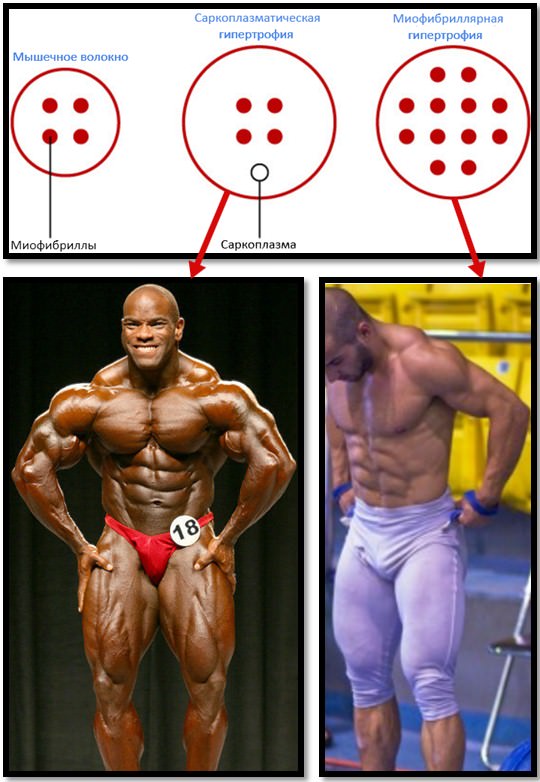
What does muscle growth depend on?
You can often hear from ectomorph guys (and not only): I can’t gain weight, I’m losing weight, what should I do? If all of this is familiar to you firsthand, then pay attention to the following three surface-related growth factors:
- type of exercise performed (basic, conditionally basic, insulating);
- consumption nutrients (positive calorie intake/calorie surplus);
- hormonal status.
These factors are called (surface-bound) due to the fact that they lie on the surface and are directly “linked” to each other (correction of one leads to changes in others). For example, changing the nature of training to a strength style with the inclusion of (,) leads to a change in hormonal status (there is a greater release of hormones into the blood) and a critical increase in hunger after exercise. Conventionally, if after isolation exercises you cannot force yourself to eat much, then after the base “everything flies away.”
The list of hormones that are responsible for muscle growth is as follows:
- IGF-1;
- beta-endorphin;
- parathyroid hormone.
The earlier the better! Why is it preferable to gain weight before age 20? Scientific answer.
The older a person gets, the more/faster the loss occurs. skeletal muscles(and their powers). And this is due, first of all, to a decrease in the ability to regenerate muscle stem cells (satellite cells), which move from a state of rest (in it they can generate new muscle progenitor cells) into an aging state. Skeletal muscle regeneration depends on a population of adult stem cells, the regenerative functions of which decline with age.
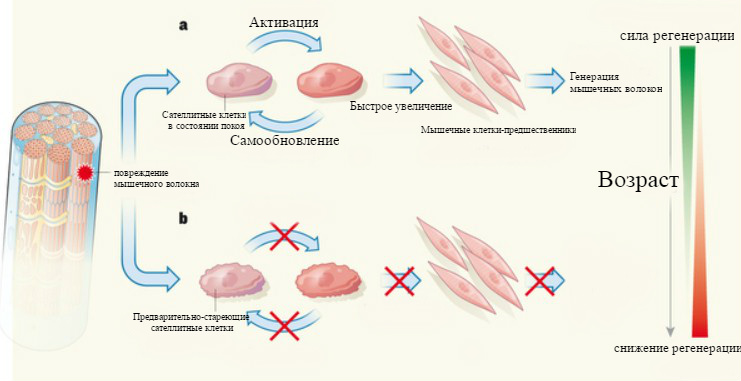
So people from 90s And 2000s years have a higher chance of “building mass” than their older colleagues from 70/80s.
Muscles, huh? What do muscles respond to?
No. 1. Response to progressive loads
The most significant factor in mass gain. Without constant muscle shock (different training schemes) and overloading them, no growth will occur. You can go to the gym for months and do “convenient” exercises, but your weight will remain practically (+/- a couple of kg) unchanged.
Conclusion: The body will build muscle mass if you prove to it that it is absolutely necessary, and for this you need to rotate the weights. For weight gain you can use the rule 2x2. This is when two workouts (for the same muscle group) conditionally in a row in the last approach you can perform two more repetitions than on the last one. On the third, you can slightly add weight to the weight.
Note:
Sooner or later, the athlete is faced with the fact that he is resting against a certain weight of the burden. For example, he cannot break through the point in the bench press. In this case, it is advisable to connect one (or several).
Load is stress for the muscles. Constant workload = constant stress, which manifests itself in 3 Muscle-enhancing aspects:
- muscle tension - a load that is not previously familiar to the muscles and which causes changes in muscle chemistry, allowing the use of growth factors such as activation of mTOR proteins and satellite cells;
- muscle damage – microtrauma/microtears of fibers that manifest themselves after training. Local muscle damage causes the release of inflammatory molecules and cells immune system, which activate satellite cells, ready to take action. Pain is damage to muscle cells caused by exercise;
- Metabolic stress – effects on muscles associated with exercise. Burning and pumping (blood pumping/muscle bloating due to accumulation of lactic acid lactate and hydrogen ions)- most prominent representatives metabolic stress.
It is these three mechanisms that are the “structural basis” for increasing muscle mass.
No. 2. Response to a “quality” training program
“The trainer wrote a program for gaining muscle mass, but the weight is worth it” - the most popular messages that come to the AB project email. Indeed, in the matter of increasing one’s loved one/beloved, PT is one of the main (second, if you like) places If we take into account the classic three days a week (Monday Wednesday Friday), then the program for beginners should be aimed at working out the whole body at a time (fullbody) or built on the top-bottom principle (for example, Monday/Friday – bottom, Wednesday – top).
Of course, there may be others, more complex circuits, and with big amount days, but these will already be tailored for experienced athletes, who need not to gain in principle, but to gain more, i.e. “hares +1” :)
Conclusion: a high-quality training program is the most significant tool in mass gain, and we will analyze them in the second part of the article.
No. 3. Response to rest and recovery
Muscles grow not in the gym, but outside it - a theorem that does not require proof. IN gym By loading our muscles, we only signal the body to start the process of building them up. The latter starts only at rest and with proper nutritional loading. Therefore, it is optimal to train in the evening, so that after classes you have an evening meal and after 1,5-2 give your body an hour good rest in the form of continuous sleep ( 7-8 hours) .
Note:
Without rest/recovery and adequate caloric intake, supercompensation will not occur, i.e. implementation of the principle “faster, higher, stronger”.
Conclusion: Muscles need rest to grow, so strictly adhere to the following principles:
- don't train anymore 2 days in a row;
- do no more 90 minutes per workout;
- use rest days wisely, carrying out restorative procedures: contrast shower, sauna, massage;
- sleep at least 7-8 hours continuously and, if possible, press the pillow during the day for about 30-40 minutes;
- having worked on a specific PT 2,5-3 Take a week's rest every month;
- After illness, train with reduced weights.
No. 4. Response to calories
Muscles don't come out of thin air; they need the right calories to grow. (their increased background compared to standard 2-3 one meal per day). How many calories does the average man need to build muscle, you ask? The answer is to dial 0,5 kg dry m.m., you need order 2800 kcal
Note:
Contractile proteins and fluid (sarcoplasm) in muscle fibers split and rebuild every time 7 - 15 days. Therefore, it is very important for a beginner, especially the first two months, to maintain an enhanced nutrition regimen and create a calorie surplus.
Conclusion: Research shows that muscles that are truly properly overloaded can grow while fasting (energy is released from fat reserves). Therefore, women in the body, while simultaneously solving the problem of gaining muscle and reducing the percentage of fatty tissue, may not be diligent in creating a calorie surplus during the day. However, if you are an ectomorph, then a surplus starting from 500 kcal/day (for women of the same build - about 250 kcal).
No. 5. Reaction to protein
Calorie content is only the “background” in gaining muscle mass; the front background is an adequate amount of grams of protein per 1 kg of target (desired) weight.
After training (and in general throughout subsequent 48 hours) muscles are in a state of protein breakdown - breakdown dominates protein synthesis. The growth of muscle mass can only occur with adequate caloric intake and a relatively high proportion of protein in it. (from 15 before 20% of total energy consumption).
With respect and gratitude, Dmitry Protasov.



